 |
stores energy |
| vs. | |
 |
supports & strengthens |
 |
stores energy |
| vs. | |
 |
supports & strengthens |
Did you know that the polymers starch and cellulose are both made by plants? In fact, plants make both starch and cellulose by connecting glucose molecules together. Every time they add a glucose to make the chain longer, a water molecule pops out! Add a glucose, out pops H2O! Add a glucose, out pops H2O! And so on and so on until the chains are really long. A starch chain can have 500 to 2 million glucose units. Cellulose can have 2,000 - 14,000 glucoses. That's a lot of sweetness!
| Glucose is a funny little molecule. Glucose likes to be in a ring, but sometimes the ring opens up. (Why? Why not? You can stand up, you can sit down. So sometimes you stand up!) | When the ring closes again, the -OH can be pointed down, or it can be pointed out. Either way, it's still glucose! |
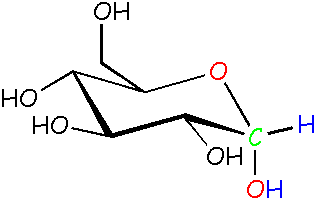 Glucose: α (alpha) form The -OH is pointed down instead of out. (We didn't draw in the C and H atoms that just hang out. |
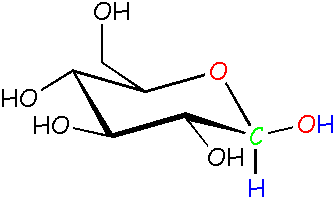 Glucose: β (beta) form See? The -OH is pointed outward instead of down. |
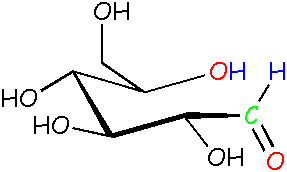 Glucose: open chain form Look at the blue H atoms. They've moved around, but they're still there. (By the way, here in science land we call these molecules isomers, because they're made up of the same atoms that are put together differently.) |
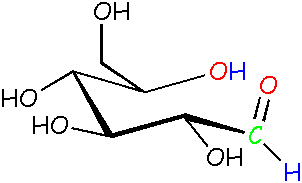 Glucose: another open chain form Compare this guy to the other open chain form on the left. It's almost the same, but one of the bonds turned around, making the red O point up instead of down. Yep, it's allowed to do that! It's like swinging your arm around. |
Plants really know how to use glucose. To make starch, they use α-glucose, with the -OH pointed down.
| That -OH is right where the next glucose will go. Since that one -OH is pointing down, it gives the chain a built-in curve. That curve is what makes starch so good for storing glucose. The starch polymer curls around and makes a nice little package. | 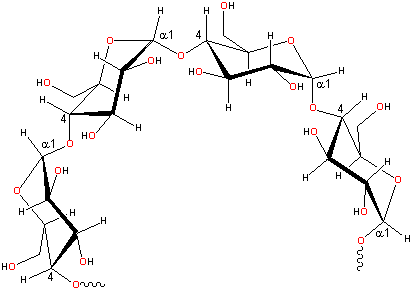 |
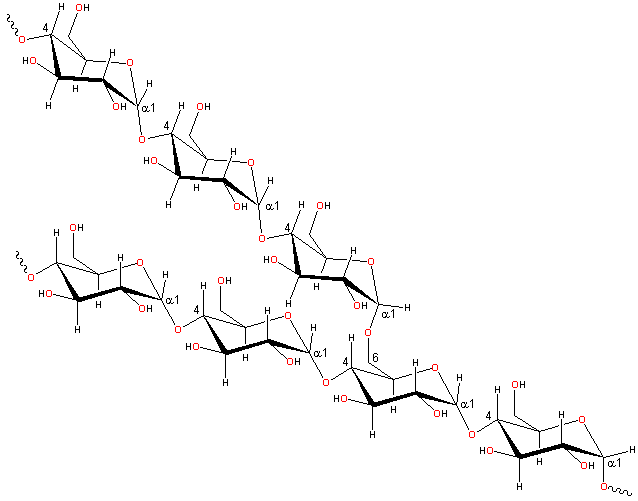 |
Many starch polymers have a lot of branches that are short chains of glucose. When plants need energy, they grab some starch and start chomping glucoses off the ends! |

Click here for an animation that shows how plants make cellulose.
Also, the chains are so close to each other, that even little molecules of water can't get in. That's good - that means that your cotton t-shirt won't wash away in the rain!
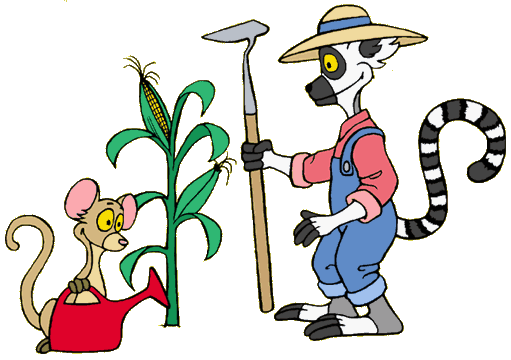 One more thing: You can eat starch, but you can't digest cellulose. Your body contains enzymes that will break starch down into glucose to fuel your body. (Click here for a way to taste this for yourself!) But we humans (and puppies and kitties) don't have enzymes that can break down cellulose.
One more thing: You can eat starch, but you can't digest cellulose. Your body contains enzymes that will break starch down into glucose to fuel your body. (Click here for a way to taste this for yourself!) But we humans (and puppies and kitties) don't have enzymes that can break down cellulose.
Some bacteria can digest cellulose. Animals like cows and horses and termites have these friendly little bacteria in their stomachs (or somewhere else in their digestive system). That means that when cows eat grass and termites eat wood, they can digest it with a little help from the microbes. No such luck for us, though! When we eat cellulose (and we do - all plants have some), it isn't used for energy, but it does help us. Click here to see how.

|
Return to Kinds of Polymers |

|
Return to Main Page |